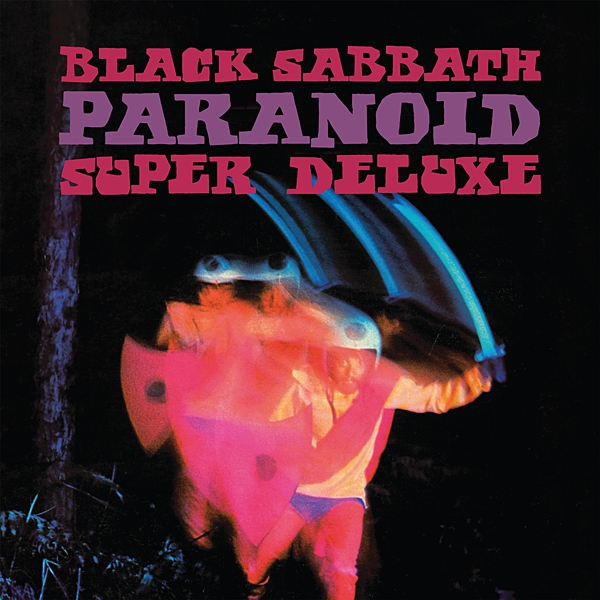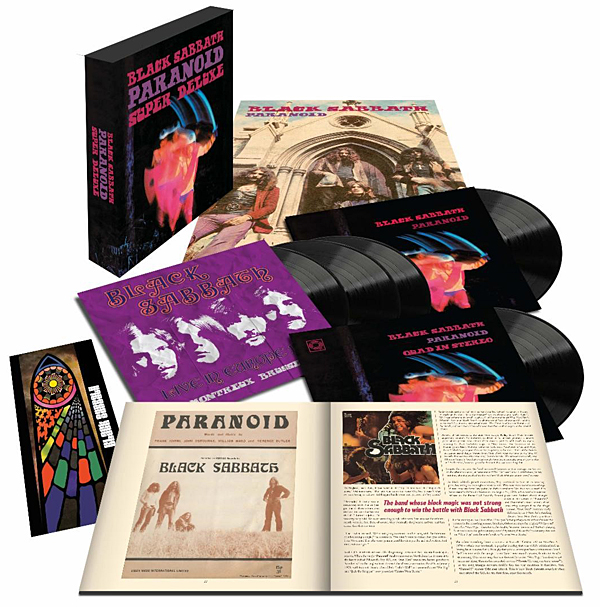| Columns Retired Columns & Blogs |
Of course people could argue about this forever, but I am pretty sure Ina Gadda Da Vida is reasonably considered to be heavy metal and certainly predates Paranoid.

The reviewer venturing to identify the birth bed of heavy metal music risks wrath. So be it.
The heavy metal genre has many roots. The idea of power chords and music centered on ominous, mythological, and vaguely threatening lyrics goes back centuries; consider the use of European church music in various eras to literally scare the hell out of believers. But heavy metal as we know it started 50 years ago with Black Sabbath's Paranoid.
A mere three years after the Summer of Love, in less than 42 minutes, Black Sabbath's second album presented a new kind of rock music, a divergence, a world full of possibilities for those who never bought into peace, love, or anything else hippie except long hair and a sense of rebellion. By 1970, the world had darkened, and Black Sabbath's vision—tales of paranoia, giant metal men dispensing vengeance on mankind, and drug-addled delusions of booted fairies—was suddenly relevant.
A half-century later, what could be more heavy metal than a global plague?
So, to mark the album's 50th anniversary, Rhino Records collected a batch of recent digital remasters, cut them to five 200gm vinyl platters, and packaged them with a hardcover book full of liner notes, full-size photos, and other early-Sabbath memorabilia, including a reproduction 1970 tour book and a poster of the band posing grimly in front of a church—the sort of thing that would hang on the bedroom wall of a teenaged me. Maybe it did.
Included in the set is Andy Pearce and Matt Wortham's 2012 remaster of the original album, a 2016 remix to 2-channel stereo of the 4-channel quadraphonic master, and three LPs of 1970 live shows mastered in 2016 by Pearce and Wortham: three sides from Montreux, Switzerland, in stereo and three sides from Brussels, Belgium, in mono. Except for the original album, all these recordings are new to vinyl. The slabs were cut by Barry Grint at Alchemy Mastering at Air Studios in the UK.

During the band's formative days in the grim industrial city of Birmingham, England, guitarist Tony Iommi damaged his fingertips in a metal press—so no more Page/Hendrix pyrotechnics on the frets. Instead, he tuned down the guitar for a uniquely dark tone and mastered building power chords into catchy tunes. Bassist Geezer Butler and drummer Bill Ward provided a solid foundation, simple and rhythmic but with a hint of free jazz. Singer Ozzy Osbourne located the narrow range in which his voice best worked its fury.
The ideas and themes presented on the band's self-titled debut merely hinted at a different kind of rock music—a foreshadowing. Then they gathered for the fast-and-furious six days at Regent Sound Studio in London that produced Paranoid.
Leading off with "War Pigs"—its darker original lyrics, nixed in America by Warner Bros., are heard in the two live performances of the tune—Sabbath laid down the marker: This album will rock harder and louder than almost any music heard before. Look out, Led Zeppelin.
Next comes the title track, composed and recorded in a single evening because producer Rodger Bain needed another song to fill out the album. The rest of the band slunk off to a pub, leaving Tony Iommi to the task. He produced a legendary riff and the band finished the song when they returned. The result: a major hit on both sides of the Atlantic.
Then came a less intense interlude, "Planet Caravan," the result of studio jamming and psychedelic sound tricks by engineer Tom Allom. Finally comes the pièce de résistance, "Iron Man," which is pure, full-frontal heavy metal.
After all that, Side 2 is anticlimactic, but it's well played and never dull. The liner notes tell the story of closing track "Fairies Wear Boots"; it's recommended reading. Suffice to say, Black Sabbath were street-tough blokes you wouldn't want to cross.
The "Quad to Stereo" version, remixed by Ray Staff at Air Studios in 2016, provides a different aural take, the familiar suddenly not. It's pleasantly disorienting. It requires your attention.
Both live shows spill over with power and intensity. The August 31, 1970, show in Switzerland offers better sound, but the band is more focused and polished a month and three days later as recorded for TV in Brussels.
Black Sabbath circa 1970 is not an audiophile affair. If you're looking to demonstrate "soundstage depth" or "holographic images," pull out that Beautiful Female Vocals album and have at it. No, this music is proletarian and animalistic. Heavy metal is not subtle or pretty. It's made to grab you, perhaps somewhere other than by your neck, and get your juices flowing. It's based on power chords, a strong bass foundation, enunciated drums, and singing that conjures the thunder, horror, and mysticism in the lyrics. At least that's the intent. With this album, Black Sabbath succeeded.
The 5 LPs are well pressed, loud and proud with quiet surfaces.—Tom Fine

Of course people could argue about this forever, but I am pretty sure Ina Gadda Da Vida is reasonably considered to be heavy metal and certainly predates Paranoid.

But then the same could be said of Steppenwolf's Born to be Wild, which came out in the same month and year as Ina Gadda Da Vida did: June, 1968.
However, neither Iron Butterfly nor Steppenwolf could be considered a "heavy" band. Both belonged to the psychedelic movement.
Black Sabbath was another story; they embodied heavy. And dark. And anti-hippie.

Born to be Wild certainly uses the phrase "heavy metal thunder".
Please remember Iron Butterfly's first album was titled "Heavy". So you can't really justify the claim that they weren't "heavy".
I like the Wikipedia article
https://en.wikipedia.org/wiki/Heavy_metal_music
if for no other reason than it shows we're all wrong and we're all right, like so much else in life.

The phrase 'heavy metal thunder' in Born To Be Wild was referring directly to Harleys hitting the road. This is a motorcycle song and was more or less the anthem of biker gangs everywhere, probably still to this day, lol.
Paranoid was an awesome album, played the death out of it. Still do occasionally.

The San Francisco band Blue Cheer was doing metal before any of them.

KerryAudio's correct that Blue Cheer predated Iommi/Osborne's much later effort.
But, predating all of them was Bubble Puppy, particularly with their song. "Hot Smoke and Sassafras", a composition which realized nearly all of the stylistic features that later became staples of heavy metal. It even provided an early example of what would much later become known as grunge/alternative music.
Going back further, many trace heavy metal's roots to an even earlier era, citing the late 1950's Link Wray as a pioneer of the style.

Sonically speaking, that would be the person who invented 'heavy metal.'
Watch out, though, perhaps The Beatles got there first! ;-D
Steppenwolf gets credit for the term, I think...."Heavy metal thunder" in Born to be Wild."
Did Black Sabbath invent Goth Rock half a decade before it had a name?

How does it sound? I know it's not a typical "audiophile" selection, but how does this version sound compare to an original copy? For instance, I have an old copy of the self titled album and in all honesty, it's one of the best sounding things I have. period. I have a remastered Paranoid on vinyl from around 2003 and it sounds mediocre to not so good. This review seems more like a history lesson on the album.

As someone who is a rabid Black Sabbath fan, it is great to see such a brilliant and influential recording being taken seriously as the metal genre is largely ignored by the music press.
You can debate what the first heavy metal song was but one thing that is undeniable is that Black Sabbath had the idea to write music that was dark and scary for the sake of being dark and scary. The name of the band and the idea stemmed from them rehearsing across the street from a theater playing the Boris Karloff movie Black Sabbath and they openly wondered that if people would pay to see scary movies, would they pay to listen to scary music?
This sound and what it stood for was a departure that set heavy metal in motion. They had an enormous influence on their generation and those to come.
I am the owner of Verdant Audio and by Stereophile rules am required to identify my self as such in every post.

The most interesting tidbit in that review was that "War Pigs" originally had different lyrics. I thought that I knew Sabbath pretty well but I didn’t know that. It turns out that the original version was called “Walpurgis” and any connection that it had to war was very indirect. The version of War Pigs that appears on Paranoid is basically a heavy metal song in the spirit of Dylan’s “Masters Of War” but the original version fits in more thematically with songs on the first album (that is to say, it’s dark, pseudo-satanic, and rocking). The only recording that I’ve been able to find of that earlier version so far was recorded by the BBC in 1970 and was for years bootlegged on LPs having titles such as “The John Peel Sessions”. The only official release that I’ve found is on a 1997 2CD Japanese release called “The Ozzman Commeth” which is a compilation that contains 4 songs from that BBC broadcast: "Black Sabbath", "War Pigs", "Fairies Wear Boots", and "Behind the Wall of Sleep" plus a whole bunch of crap that Ozzie recorded as a solo artist. The sound quality of those ”John Peel” tracks is murky but worth listening to at least once if you're a fan.